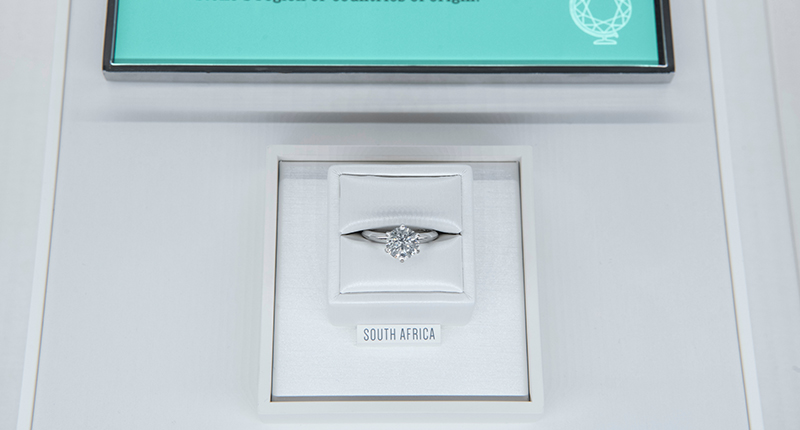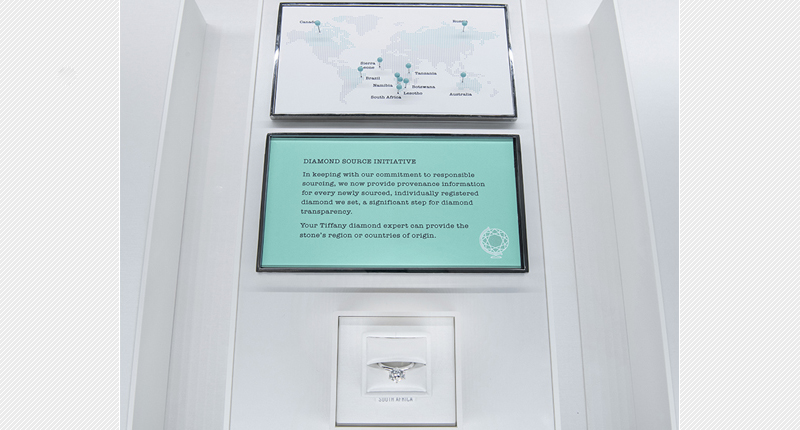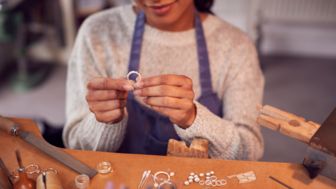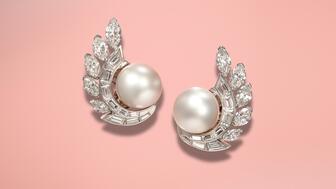The entrepreneur and “Shark Tank” star will share his top tips for success.
Tiffany Is Now Telling Consumers the Origin of Its Diamonds
Next year, the jeweler will start sharing information on where stones were cut and polished.

There’s now a map inside with 10 pins dropped on countries from Canada to Australia above a plaque that reads: “In keeping with our commitment to responsible sourcing, we now provide provenance information for every newly sourced, individually registered diamond we set, a significant step for diamond transparency.”
The plaque and the map—both with touches of Tiffany blue, of course—are part of what the jeweler is calling the “Diamond Source Initiative,” which it rolled out worldwide last month.
Now when customers come into any of Tiffany’s 300-plus stores, salespeople will be able to tell them the country of origin for most “individually registered” diamonds—diamonds that are 0.18 carats or larger and have been laser-engraved with “T&Co.” and a unique serial number.
There are, of course, a couple exceptions.
Diamonds sourced from De Beers, which does not segregate production from its various mines in southern Africa and Canada, will be labeled “Botswana sort.” Most of the stones, Tiffany said, were mined in Botswana, with some originating from mines in Namibia, South Africa and Canada.
For diamonds that pre-date the program’s rollout, Tiffany said it will provide confirmation to consumers that the diamond was sourced responsibly.

Tiffany started sharing diamond origin in its stores on Jan. 9, though it could have begun doing so years ago.
Andy Hart, Tiffany’s senior vice president of diamond jewelry and supply, said former Chairman and CEO Michael Kowalski started Tiffany down the path of charting diamond origin in the late ‘90s.
In 2002, Tiffany established Laurelton Diamonds, the jeweler’s rough sourcing arm that is a De Beers sightholder, and a client of Alrosa and Canadian miner Dominion Diamond.
In 2003, it began laser-inscribing its diamonds with unique serial numbers that are recorded in a database that contains information about each stone’s journey from mine to market.
So, why wait until now to start sharing source information with consumers?
“For a long time, we felt we were doing it because it was the right thing to do, and it was good for the company and it was good for the industry,” Hart said. “I think our customers deserve to know what is going on behind the scenes.”

“We just felt like now was the right moment in Tiffany’s history to disclose the origin to our customers,” he said. “We really believe in the rarity and the incredible nature of diamonds. Diamonds grown in the lab have important uses in particular contexts and are going to perhaps have a greater use in the in the jewelry industry.”
But, Hart said, Tiffany won’t be using the stones in its jewelry.
“Natural diamonds create opportunity for people in countries where diamonds are a natural resource, such as Botswana. We believe in the opportunity to make, and we are making, a positive impact in those local communities.”
The Latest

The Ukrainian brand’s new pendant is modeled after a traditional paska, a pastry often baked for Easter in Eastern European cultures.

The jeweler has announced a grand reopening for its recently remodeled location in Peoria, Illinois.

Interior designer Athena Calderone looked to decor from the 1920s and 1930s when crafting her first fine jewelry collection.


During a call about its full-year results, CEO Efraim Grinberg discussed how the company is approaching the uncertainty surrounding tariffs.

The free program provides educational content for jewelry salespeople and enthusiasts to learn or refresh their diamond knowledge.

Bench jewelers spend years honing their skills, Jewelers of America’s Certification validates their talents.

The feedback will be used to prepare other jewelers for the challenges ahead, the organization said.

The online sessions are designed to teach jewelers to use AI tools like ChatGPT and Claude to grow their business.

The opening marks the jewelry retailer’s first location in the Midwest.

The “United in Love” collection offers tangible mementos of hearts entwined with traditional and non-traditional commitment heirlooms.

Robert Goodman Jewelers will hold a “Black Jewelry Designers and Makers” event on April 27.

Editor-in-Chief Michelle Graff answers questions about how the new taxes levied on countries like India and China will impact the industry.

Kenewendo, Botswana’s minster of minerals and energy, discusses closing the deal with De Beers and the work that was missed along the way.

The historic fancy vivid blue diamond set to headline Christie’s Geneva sale next month could sell for up to $50 million.

LVMH CFO Cécile Cabanis also discussed the effects of tariffs so far.

The “Mad Men” and “The Morning Show” star steals jewelry, art, and handbags from his wealthy neighbors in “Your Friends & Neighbors.”

The organization has reelected Kalpesh Jhaveri as president.

An investigation found that the former managing director of Movado’s Dubai branch overstated and prematurely recorded sales.

The collection pays tribute to the Japanese philosophy of Ma, studying balance, stillness, and the interplay between presence and absence.

Mari Lou’s Fine Jewelry in Orland Park, a suburb of Chicago, is closing its doors.

GIA’s labs in Dubai and Hong Kong are now accepting larger diamonds in light of the “logistical challenges” presented by the new tariffs.

These earrings by Van Cleef & Arpels, featuring the same design as a pair worn by Princess Grace, are up for auction at Woolley & Wallis.

Two experts share how artificial intelligence tools can help retailers run a more efficient business.

Kentaro Nishimura, who has been with the pearl company since 1997, has been promoted to president and CEO of Mikimoto America.

“America Telling Time: 150 Years of Bulova” explores the storied history of the American watchmaker.



























